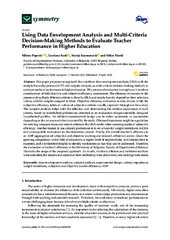Please use this identifier to cite or link to this item:
https://rfos.fon.bg.ac.rs/handle/123456789/2041Full metadata record
| DC Field | Value | Language |
|---|---|---|
| dc.creator | Popović, Milena | |
| dc.creator | Savić, Gordana | |
| dc.creator | Kuzmanović, Marija | |
| dc.creator | Martić, Milan | |
| dc.date.accessioned | 2023-05-12T11:26:56Z | - |
| dc.date.available | 2023-05-12T11:26:56Z | - |
| dc.date.issued | 2020 | |
| dc.identifier.issn | 2073-8994 | |
| dc.identifier.uri | https://rfos.fon.bg.ac.rs/handle/123456789/2041 | - |
| dc.description.abstract | This paper proposes an approach that combines data envelopment analysis (DEA) with the analytic hierarchy process (AHP) and conjoint analysis, as multi-criteria decision-making methods to evaluate teachers' performance in higher education. This process of evaluation is complex as it involves consideration of both objective and subjective efficiency assessments. The efficiency evaluation in the presence of multiple different criteria is done by DEA and results heavily depend on their selection, values, and the weights assigned to them. Objective efficiency evaluation is data-driven, while the subjective efficiency relies on values of subjective criteria usually captured throughout the survey. The conjoint analysis helps with the selection and determining the relative importance of such criteria, based on stakeholder preferences, obtained as an evaluation of experimentally designed hypothetical profiles. An efficient experimental design can be either symmetric or asymmetric depending on the structure of criteria covered by the study. Obtained importance might be a guideline for selecting adequate input and output criteria in the DEA model when assessing teachers' subjective efficiency. Another reason to use conjoint preferences is to set a basis for weight restrictions in DEA and consequently to increase its discrimination power. Finally, the overall teacher's efficiency is an AHP aggregation of subjective and objective teaching and research efficiency scores. Given the growing competition in the field of education, a higher level of responsibility and commitment is expected, and it is therefore helpful to identify weaknesses so that they can be addressed. Therefore, the evaluation of teachers' efficiency at the University of Belgrade, Faculty of Organizational Sciences illustrates the usage of the proposed approach. As results, relatively efficient and inefficient teachers were identified, the reasons and aspects of their inefficiency were discovered, and rankings were made. | en |
| dc.publisher | MDPI, Basel | |
| dc.relation | Faculty of Organizational Sciences | |
| dc.relation | info:eu-repo/grantAgreement/MESTD/Technological Development (TD or TR)/33044/RS// | |
| dc.relation | info:eu-repo/grantAgreement/MESTD/Integrated and Interdisciplinary Research (IIR or III)/44007/RS// | |
| dc.rights | openAccess | |
| dc.rights.uri | https://creativecommons.org/licenses/by/4.0/ | |
| dc.source | Symmetry-Basel | |
| dc.subject | weight restrictions | en |
| dc.subject | subjective and objective teacher efficiency | en |
| dc.subject | experimental design | en |
| dc.subject | data envelopment analysis | en |
| dc.subject | criteria importance | en |
| dc.subject | conjoint analysis | en |
| dc.subject | AHP | en |
| dc.title | Using Data Envelopment Analysis and Multi-Criteria Decision-Making Methods to Evaluate Teacher Performance in Higher Education | en |
| dc.type | article | |
| dc.rights.license | BY | |
| dc.citation.issue | 4 | |
| dc.citation.other | 12(4): - | |
| dc.citation.rank | M22 | |
| dc.citation.volume | 12 | |
| dc.identifier.doi | 10.3390/sym12040563 | |
| dc.identifier.fulltext | http://prototype2.rcub.bg.ac.rs/bitstream/id/642/2037.pdf | |
| dc.identifier.rcub | conv_2328 | |
| dc.identifier.scopus | 2-s2.0-85085662352 | |
| dc.identifier.wos | 000540222200074 | |
| dc.type.version | publishedVersion | |
| item.cerifentitytype | Publications | - |
| item.fulltext | With Fulltext | - |
| item.grantfulltext | open | - |
| item.openairetype | article | - |
| item.openairecristype | http://purl.org/coar/resource_type/c_18cf | - |
| Appears in Collections: | Radovi istraživača / Researchers’ publications | |
This item is licensed under a Creative Commons License


